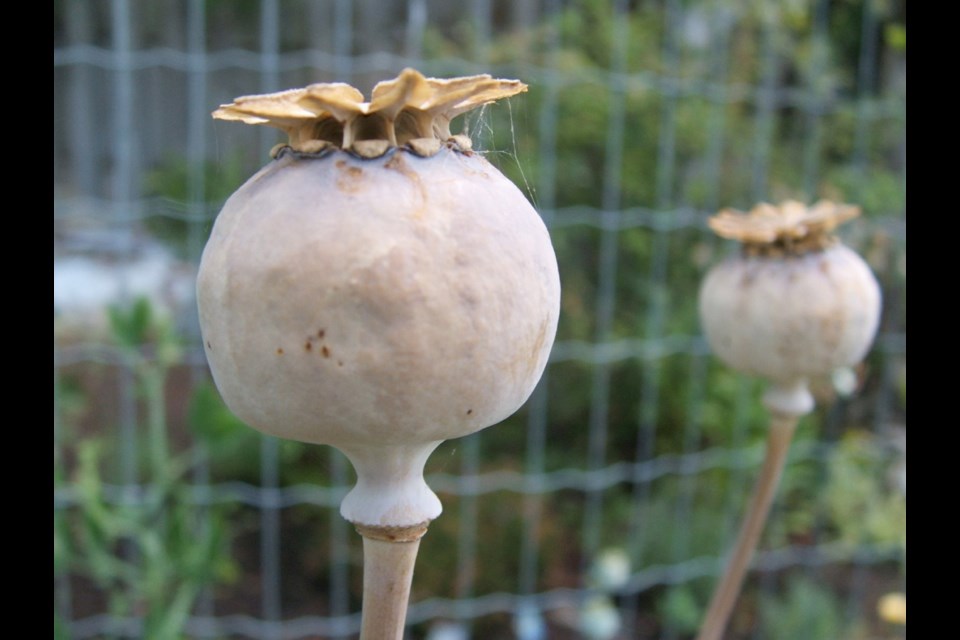Dear Helen: How do I know when it’s the right time to gather seeds from the large pods left on my peony-flowered annual poppies?
P.K.
There are several sure indicators of the seeds being ready for harvesting. First, the plump, upright seed capsules should be fully dry. Holes should have opened up immediately below the neat little disk that tops the capsule. The final sign is a free rattling of the seeds within the capsule when it is shaken gently.
I harvest the capsules by cutting them off carefully and depositing them into a paper bag, which I then store in a dry, dark, cool place until I’m ready to extract the seeds. This is done by upending each capsule and shaking it, as you would a salt shaker, over a clean, dry container.
Dear Helen: What were the rusty markings on my garlic plants? The bulbs themselves seem all right, though they are smaller than those I harvested last year. I did not compost the tarnished tops.
B.D.
Cool, wet weather through early July made our garlic plantings (and many other plants) highly vulnerable to an array of diseases. One of them is garlic rust, a fungus that causes rusty orange specks on the foliage. Upon digging the bulbs, you made the right choice to destroy the infected leaves.
Effects of the disease on the harvested bulbs are minimal. They should store well. The infection can reduce the bulb size, but this year’s home garden bulbs have generally been smaller than the supersized bulbs many of us harvested last year.
Watch for rust on other onion family plants in the garden. Leeks and chives are examples. Get rid of any infected plants by late autumn, before they can transfer disease spores to any extra-early green garlic shoots, which sometimes appear early in the winter.
Another key disease prevention measure is to wait four years before planting garlic or any other onion family plant in a space. Dormant disease spores eventually die in the absence of a host.
Every year, in late summer, I make a rough sketch of the vegetable garden with all the major plant types positioned on it. I keep them on a clipboard for easy access to individual planting sites over recent years. Those pages are a helpful guide to keeping plantings moved carefully around from year to year.
Dear Helen: For two years now, paper wasps have built nests in my greenhouse. They are not at all aggressive and their small nests are interesting. Are they native insects, and beneficial?
W.S.
That depends on the kind of paper wasp you have. The European paper wasp is considered invasive, and damaging to fruit and berry crops. It builds small, papery, umbrella-shaped nests on eaves, porch ceilings and similar locations as well as in trees and shrubs. These insects have black and yellow stripes similar to yellow jacket wasps, but the bodies are more elongated with a narrow, pinched-in waist.
Native paper wasps are more golden in colour, with more elongated, thinner waists. They are considered beneficial as pollinators and pest predators.
You will find descriptions and colour photos of European and native paper wasps, and of yellow jackets, at beefriendly.ca/paper-wasp-nests/. The nests of all three are also pictured.
Dear Helen: Why did all the early flowers on my strong and healthy heirloom tomato plants dry up without any fruit forming?
A.M.
Tomatoes and other warmth-loving plants did not fare well in the unusually cool and wet, almost fall-like late spring and early summer weather this year. I’ve heard from many gardeners whose melon plants expired in the daunting conditions, which also made successful pollination of tomato flowers more than challenging.
Many, but not all, heirloom tomato varieties need a long season of sun and warmth to yield a successful crop. And they demand near perfect conditions for a good fruit set.
Having said that, I should note that my heirloom Japanese Black Trifele tomato plants developed fruit from the very first blossoms, low down on the plants. Those first fruits ripened a week ago. This variety is an unusually easy-growing, prolific producer of tomatoes with a rich flavour.
Your tomatoes most likely began forming fruit with the arrival of warm weather, but because of the late start some of our plants may prove disappointing this summer.



